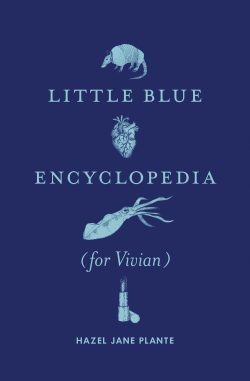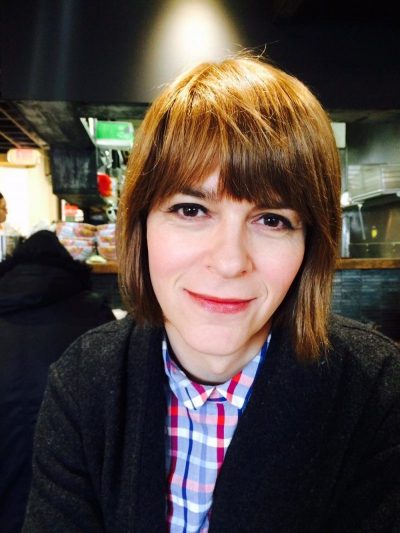#689 Little Blue Island almanac
Little Blue Encyclopedia (for Vivian)
by Hazel Jane Plante
Montreal: Metonymy Press, 2019
$18.95 / 9780994047199
Reviewed by Paul Headrick
*
 Are there popular reference works about successful TV shows? The Encyclopedia of Breaking Bad or A Viewer’s Guide to The Brady Bunch certainly wouldn’t have universal appeal, though perhaps there’d be a guaranteed readership of a certain size. But what of a reference work about a show that’s entirely imaginary? What pleasure could be taken from reading a long sequence of alphabetized entries detailing the minutia of a TV series one can’t watch? And then, how could such a book possibly be an encyclopedia and, at the same time, a novel?
Are there popular reference works about successful TV shows? The Encyclopedia of Breaking Bad or A Viewer’s Guide to The Brady Bunch certainly wouldn’t have universal appeal, though perhaps there’d be a guaranteed readership of a certain size. But what of a reference work about a show that’s entirely imaginary? What pleasure could be taken from reading a long sequence of alphabetized entries detailing the minutia of a TV series one can’t watch? And then, how could such a book possibly be an encyclopedia and, at the same time, a novel?
This strange concoction is what Hazel Jane Plante has attempted with her debut work. Oddball narrative structures can seem arbitrary — stylistic dead ends whose appeal is limited to trickiness for its own sake. Little Blue Encyclopedia hits no dead end. Its quirky form emerges organically from the narrator’s complex situation and psychology. The result is a subtle, moving literary wonder.
The narrator summarizes her undertaking in the opening paragraph:
This book is about Little Blue, a television series that’s adored by a small cluster of people. One of its keenest devotees was my friend Vivian Cloze. Like the series itself, she was enigmatic, flawed, and well loved. This book is as much about Vivian as it is about Little Blue (p. 1).

The TV series presents the lives of a large cast of characters who live on Little Blue Island. The encyclopedia that the narrator creates expresses her devotion to those characters, while also allowing her to mourn for her friend and to try to recover from her loss:
When Vivian died, my world collapsed. I wept for what felt like days, weeks, months. Everything and everyone around me receded. Objects blurred. Colours drained. Sounds muffled (p. 1).
Vivian was, at least on the surface, the more powerful one in their friendship. Outgoing, adventurous, and confident, she led while the narrator followed, including introducing the narrator to the show that entrances them so. Even more importantly, Vivian was a trans woman, while, when they met, the narrator was just coming to the point of realizing that she too is trans. Vivian became her mentor as she faced the challenges of expressing her gender identity. The dynamic between the two was, however, complicated by their different orientations: Vivian was into men, while the narrator is attracted to women, and was in love — unrequitedly and heartbreakingly so — with her friend.
The encyclopedia, then, is a tribute, and a way for the narrator to sustain and reflect on her connection with Vivian. The entries are utterly charming and crazily imaginative — many readers will respond as I did and feel a slight ache for being unable ever to watch Little Blue — and with every description the narrator expresses her love and her sorrow, while moving ever-so-gently toward greater understanding.
Here’s the first entry in the encyclopedia:
Captain Alphonse abandoned his wife and child the day after his son spoke his first word. We never see any images of Alphonse, nor do we discover his family name, what he was “captain” of, or (most importantly) why he left his wife and young son. Captain Alphonse is described either vaguely or contradictorily. When someone says “He was the real deal” with no other information, what does that mean? And how can you be “a man’s man to beat the band” and have the nickname Twinkle Toes? Was the nickname meant to be a joke, like calling a large kid Tiny? Somehow, he managed to captivate Ranjit Jha, the most beautiful woman on Little Blue Island, who continued to love him even after he abandoned her and their child, Tristan.
In the character of Captain Alphonse, I get a whiff of what Vivian was attracted to in men: an airy charm, a greasy charisma. And good hair (pp. 21-22).
The structure here is somewhat typical, with the description of the character followed by a recollection or comment about Vivian. Other entries lead to much more reminiscing, and in this way, as our sense of the show becomes more detailed, so does the novel build a fuller picture of Vivian and the narrator’s relationship with her. The story of Alphonse and Ranjit is also consistent with the impression that the other entries generate — that the TV series is whimsical and sometimes puzzling, with the complicated and at times hilarious stories of individual characters often having a folk-tale quality.

Then there’s the narrative voice, perhaps the novel’s greatest success. It’s relaxed, intelligent — even elegant — but straightforward, and capable with regularity of pulling off a delightfully evocative surprise such as “greasy charisma.” These flourishes never seem strained, never reaching for effect. The last time I read a novel with such a startling, original, winning first-person narrator was Miriam Toews’s A Complicated Kindness.
In this first entry the novel also establishes one of its most intriguing features: many of the characters and events from Little Blue are slyly connected to the narrator’s life. Ranjit’s enduring love for Alphonse despite his abandonment, the narrator’s undying love for Vivian: one reflects the other. The hint of gender ambiguity in the entry, funny but perplexing, also evokes associations with the narrator and Vivian. Plante handles this correspondence between the TV show and the lives of the narrator and her beloved with a confident, deft touch. The parallels are subtle, but they imbue one entry after another with a compelling undercurrent.
The book itself is a beautiful object, designed by “LOKI” and illustrated, with a sophisticated simplicity in keeping with the story, by Onjana Yawngwhe.
Once in a rare while a work from a small, independent press overcomes the limitations of a tiny marketing budget and an author with no name recognition, to become a big hit. Sometimes it’s a few open-minded judges for an important literary prize who do the trick. Little Blue Encyclopedia (for Vivian) deserves that kind of success. I could easily see it bringing together a readership as intelligently devoted to its characters, as warmly united by a love for art, as the narrator and her dear Vivian were to Little Blue Island.
*

Paul Headrick is the author of a novel, That Tune Clutches My Heart (Gaspereau Press, 2008; finalist for the BC Book Prize for Fiction), and a collection of short stories, The Doctrine of Affections (Freehand Books, 2010; finalist for the Alberta Book Award for Trade Fiction). He has also published a textbook, A Method for Writing Essays about Literature (Thomas Nelson, 2009; 3rd edition 2016). Paul has an M.A. in Creative Writing and a Ph.D. in English Literature. He taught creative writing for many years at Langara College and gave workshops at writers’ festivals from Denman Island to San Miguel de Allende, Mexico. He is a mentor for the graduate fiction workshop in The Writer’s Studio at SFU. Editor’s note: Paul Headrick has also reviewed books by Anakana Schofield, Deni Ellis Béchard, Linda Rogers, Kathy Page (Dear Evelyn), Kathy Page (The Two of Us), and Karen Charleson for The Ormsby Review.
*
The Ormsby Review. More Books. More Reviews. More Often.
Publisher and Editor: Richard Mackie
The Ormsby Review is a journal service for serious coverage of B.C. books and authors, hosted by Simon Fraser University. The Advisory Board consists of Jean Barman, Robin Fisher, Cole Harris, Wade Davis, Hugh Johnston, Patricia Roy, David Stouck, and Graeme Wynn. Scholarly Patron: SFU Graduate Liberal Studies. Honorary Patron: Yosef Wosk. Provincial Government Patron since September 2018: Creative BC
“Only connect.” – E.M. Forster
One comment on “#689 Little Blue Island almanac”